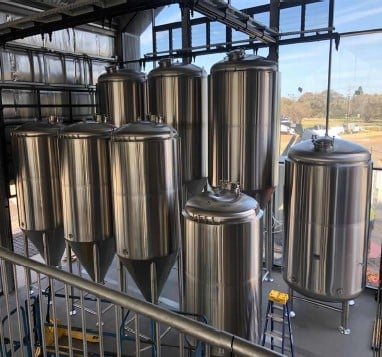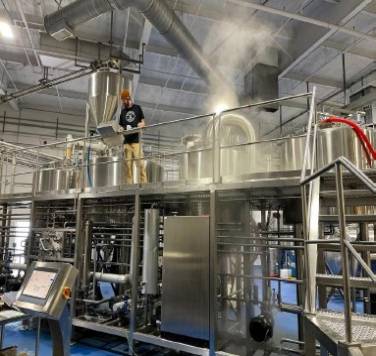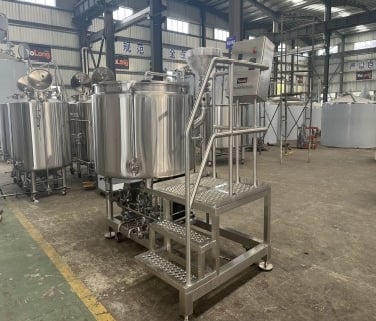Fermentation tank
Ever wondered where the magic happens? How that delicious beer you’re enjoying came to be? Or perhaps you’re curious about the science behind tangy yogurt or bubbly kombucha? Well, wonder no more! The answer lies in a fascinating piece of equipment called a fermentation tank.
In this comprehensive guide, we’ll delve into the world of fermentation tanks, exploring their intricate details, functionalities, and how they play a crucial role in various fermentation processes. We’ll equip you with the knowledge to navigate the different types of tanks, understand their functionalities, and even provide insights on choosing the perfect one for your needs.
What is a Fermentation Tank?
A fermentation tank is a sealed container specifically designed to control and optimize the fermentation process. Fermentation, for the uninitiated, is a metabolic process where microorganisms like yeast or bacteria convert sugars into other products, often including alcohol, acids, or gases. This process is harnessed in the production of a vast array of products we consume daily, from beer and wine to cheese, yogurt, and even pharmaceuticals.
The fermentation tank acts as a controlled environment, providing the ideal conditions for these tiny organisms to thrive and perform their task efficiently. Imagine it as a cozy apartment complex specifically designed for your microscopic roommates, complete with temperature control, ventilation, and even agitation systems to keep them happy and productive!

Types of Fermentation Tanks
Fermentation tanks come in various shapes, sizes, and configurations, each suited for specific applications. Here’s a breakdown of the most common types:
| Type of Tank | Description | Applications |
|---|---|---|
| Cylindrical Tanks (Horizontal or Vertical) | The most common type, featuring a cylindrical body with dished heads. Horizontal tanks offer easier access for cleaning, while vertical tanks are space-saving. | Beer, wine, cider, sake production |
| Conical Tanks | These tanks have a cone-shaped bottom that allows for easier collection of sediment during fermentation. | Beer with high yeast sedimentation, Kombucha |
| Jacketed Tanks | These tanks feature a double wall that allows for the circulation of coolant or heating fluid, enabling precise temperature control during fermentation. | Products requiring strict temperature control like pharmaceuticals, some beers, and yogurt |
| Pressure Tanks | Designed to withstand higher pressures, these tanks are suitable for fermentation processes that produce CO2 gas, like beer or sparkling wine. | Carbonated beverages |
Features of Fermentation Tanks
Modern fermentation tanks are equipped with various features to ensure optimal fermentation conditions and efficient operation. Some key features include:
- Temperature control systems: Maintaining a consistent temperature is crucial for various fermentation processes. Fermentation tanks may have jackets for heating or cooling, or integrated sensors and controllers for automated temperature management.
- Pressure control systems: For pressure-sensitive fermentations or those producing CO2, pressure control systems are essential to maintain safe and optimal conditions.
- Agitation systems: Some fermentations benefit from gentle mixing or agitation to keep the ingredients suspended and promote even fermentation. This can be achieved through mechanical or pneumatic agitators.
- Sampling ports: These ports allow brewers or producers to collect samples throughout the fermentation process to monitor progress and quality.
- Cleaning systems: Maintaining a clean and sanitized fermentation tank is vital to prevent contamination. Some tanks may have built-in cleaning systems or features that facilitate easy cleaning.
The Brewing Process with Fermentation Tanks
Let’s take a closer look at how fermentation tanks play a pivotal role in the brewing process:
- Wort Preparation: The brewing process begins with the creation of wort, a sugary liquid derived from malted grains.
- Transfer to Fermentation Tank: Once cooled, the wort is transferred to the fermentation tank.
- Yeast Pitching: Yeast is then introduced into the wort. These tiny organisms are the key players in converting the wort’s sugars into alcohol and CO2.
- Controlled Fermentation: The fermentation tank provides the ideal temperature and pressure conditions for the yeast to thrive and convert the sugars. During this stage, the characteristic flavors and aromas of the beer develop.
- Maturation (Optional): Some beers benefit from a secondary fermentation or conditioning period in the tank to allow for further flavor development and CO2 saturation.
- Packaging: Once fermentation is complete, the beer is transferred to kegs, bottles, or cans for packaging and distribution.
Factors to Consider When Choosing a Fermentation Tank
Selecting the right fermentation tank depends on several factors, including:
- Product: The type of product you’re fermenting will influence the tank size, features, and materials required.
- Batch size: Consider the volume of product you intend to produce per batch. Tanks come in a wide range of sizes, from small homebrew units to massive industrial tanks.
- Budget: Fermentation tanks can range significantly in price depending on size, features, and materials. Determine your budget and choose a tank that offers the necessary functionalities without breaking the bank.
- Material: Stainless steel is the most common material for fermentation tanks due to its durability, ease of cleaning, and resistance to corrosion. However, some applications may utilize food-grade plastic or other materials.
- Available Space: Consider the physical footprint of the tank and ensure you have adequate space for installation, operation, and cleaning.
- Expandability: If you anticipate scaling up production in the future, consider a tank design that allows for easy expansion or the addition of more tanks.
Suppliers and Price Range of Fermentation Tanks
The price of a fermentation tank can vary widely depending on the factors mentioned above. Here’s a general breakdown to provide a starting point for your research:
| Tank Capacity | Typical Price Range |
|---|---|
| Homebrew (1-10 gallons) | $100 – $500 |
| Small-scale Production (50-100 gallons) | $1,000 – $5,000 |
| Commercial Production (500-1000 gallons) | $5,000 – $20,000 |
| Large-scale Production (Over 1000 gallons) | Custom Quote |
Here are some popular suppliers of fermentation tanks to get you started:
- Speidel: Renowned for their high-quality plastic homebrew and small-scale fermentation tanks.
- GW Kent: Offers a wide range of fermentation tanks for various applications, from homebrew to large-scale production.
- Glacier Tanks: Specializes in high-quality stainless steel tanks for breweries and cideries.
- Stout Tanks and Kettles: Provides a good selection of homebrew and small-batch fermentation tanks at competitive prices.
Remember: These are just a few examples, and many other reputable suppliers offer fermentation tanks. It’s advisable to research and compare options from various vendors to find the best fit for your needs and budget.
Installation, Operation, and Maintenance of Fermentation Tanks
Installation:
The complexity of installing a fermentation tank depends on its size and features. For simple homebrew tanks, installation may involve basic plumbing connections. However, larger commercial tanks may require specialized equipment and expertise for proper setup. It’s always recommended to consult the manufacturer’s instructions and consider professional assistance for complex installations.
Operation:
Operating a fermentation tank involves monitoring and controlling various parameters throughout the fermentation process. This may include:
- Temperature control: Maintaining the desired temperature range is crucial for optimal fermentation.
- Pressure control (if applicable): For pressure-sensitive ferments or those producing CO2, pressure needs to be monitored and adjusted as needed.
- Yeast pitching: Adding the correct amount of yeast strain at the appropriate stage is essential.
- Nutrient addition: Certain fermentations may require the addition of nutrients to support healthy yeast growth.
- Monitoring progress: Taking samples periodically allows you to assess the progress of fermentation and make adjustments if necessary.
Cleaning and Maintenance:
Maintaining a clean and sanitized fermentation tank is vital to prevent contamination and ensure consistent product quality. Here are some general cleaning and maintenance practices:
- Cleaning after each use: Thoroughly clean the tank after each fermentation cycle using appropriate cleaning solutions and sanitizers.
- Regular maintenance: Perform regular maintenance checks on gaskets, valves, and other components to ensure proper operation.
- Calibration: Calibrate temperature and pressure control systems periodically to ensure accuracy.
Choosing the Right Fermentation Tank Supplier
Finding the right supplier for your fermentation tank is just as important as choosing the tank itself. Here are some key factors to consider:
- Reputation and experience: Look for a supplier with a proven track record of providing high-quality fermentation tanks.
- Product selection: Ensure the supplier offers a range of tanks that cater to your specific needs and application.
- Customer service: Choose a supplier with a responsive and knowledgeable customer service team to assist you with any questions or concerns.
- Pricing and warranty: Compare prices and warranty terms from different suppliers to find the best value for your investment.

:
Pros and Cons of Fermentation Tanks
Pros:
- Controlled environment: Fermentation tanks provide a controlled and consistent environment for optimal fermentation, leading to higher quality and more consistent products.
- Scalability: Tanks come in various sizes, allowing you to scale your production up or down as needed.
- Efficiency: Features like temperature control and agitation systems can improve the efficiency of the fermentation process.
- Hygiene and sanitation: Tanks with smooth surfaces and easy cleaning procedures promote better hygiene and sanitation, reducing the risk of contamination.
- Versatility: Some fermentation tanks can be adapted for use with various fermentation processes.
Cons:
- Cost: High-quality fermentation tanks can be a significant investment, especially for larger models.
- Complexity: Operating larger commercial tanks may require specialized training or knowledge.
- Space requirements: Tanks, especially large ones, require dedicated space for installation, operation, and cleaning.
- Maintenance: Regular cleaning and maintenance are essential to ensure the longevity and functionality of the tank.
FAQ
Q: What is the difference between a fermenter and a fermentation tank?
A: In essence, there is no significant difference between a fermenter and a fermentation tank. Both terms refer to the sealed container used to control and house the fermentation process.
Q: Can I use a food-grade plastic bucket as a fermentation tank?
A: For small-scale homebrewing or fermentation projects, food-grade plastic buckets can be suitable. However, they may not offer the same level of temperature control, durability, or ease of cleaning as stainless steel tanks.
Q: How do I clean and sanitize my fermentation tank?
A: Cleaning procedures can vary depending on the size and features of your tank. Generally, you’ll want to use a warm, caustic cleaning solution followed by a thorough rinse and sanitization with a no-rinse sanitizer. Always refer to the manufacturer’s instructions for specific cleaning and sanitation protocols.
Q: Where can I learn more about fermentation?
A: There are many excellent resources available online and in libraries to learn more about fermentation. The American Homebrewers Association (https://www.homebrewersassociation.org/) and the National Center for Home Food Preservation (https://nchfp.uga.edu/how/can) are great starting points.













